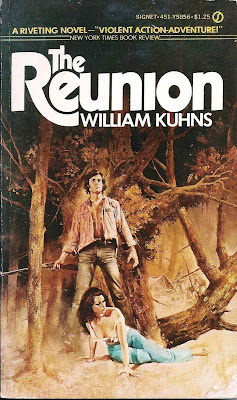Book Review: 'Storm Season' edited by Robert Asprin and Lynn Abbey
'Storm Season' (305 pp.) was published by Ace Books in October, 1982, and features cover art by Walter Vellez.
This is the fourth volume in the initial, six-volume launch of the 'Thieves' World' shared world anthologies. Probably the best way to access 'Storm Season,' along with volumes five ('The Face of Chaos') and six ('Wings of Omen') is via the hardcover omnibus 'Cross-Currents,' published in 1984 by Nelson Doubleday.
My review of the first volume in the franchise, 'Thieves' World,' is here. My review of the second volume, 'Tales from the Vulgar Unicorn,' is here.
It helps to have read some of the earlier entries in the series before tackling 'Storm Season,' as the lead and supporting characters are recurring, and the plots in 'Storm' follow events described in the earlier stories. All of these taking place, of course, in and around the reeking alleys, taverns, and brothels of
Sanctuary, the city of Thieves.
In a determined effort to move away from Ye Olde Style of fantasy literature, the stories in Thieves' World are gritty and transgressive in tone, borrowing more from noir fiction than heroic or epic fantasy. Depravities and violence abound in Sanctuary, and noble quests, and noble people, are in short supply...........
The better entries in 'Storm' include 'Exercise in Pain,' by editor Asprin. In this tale, Jubal the mercenary is forced to acknowledge that a violent lifestyle can have its consequences. Asprin asks a question that is surprisingly absent in many action-centered fantasy stories: what happens to those who are grievously wounded in combat ? In fantasy tales, there are no emergency rooms nor physical therapy centers - !
'Steel,' by Lynn Abbey, features a well-constructed plot and an appealing lead character in Walegrin, a fighter hoping to advance his career, and exit the squalor of Sanctuary, via the blacksmithing of some wonder-weapons.
Diana Paxson, an author who I would have thought a little too refined, a little too couth, for the Thieves' World concept, contributes 'A Fugitive Art,' about a painter who finds himself caught up in political intrigue. In Sanctuary, unfortunately, political intrigue can mean an early death......another well-plotted tale that benefits from clear and readable prose.
Unfortunately for 'Storm Season,' the other tales are mediocre, suffering from too-thin plots that are padded with over-writing.
C. J. Cherryh's 'Downwind' features a soldier of fortune named Mradhon Vis, who is so down on his luck that he is obliged to take lodgings at the lowliest of inns in Sanctuary: Mama Becho's. In order to stay solvent, Vis has to make some deals with unsavory characters. Cherryh's plot is poorly constructed and I found myself struggling to figure things out much too often.
Janet Morris's 'Wizard Weather' is overwritten and awkward. Prepare for words like:
'horripilation'
'omina' (plural of 'omen' ?!)
'entelechy' (something to do with the material manifestation of an ethereal being)
And phrases such as:
'contractural protective wardings'
'mountainous skirts'
'ersatz-daylight'
and
'...a soapy, scum-covered sky gone noncommittal.'
The plot is convoluted, and has something to do with a disagreement between gods, and the machinations of a witch named Cime, who is going around killing wizards. Her brother Tempus, the head of the Imperial Guard, has troubles of his own, but nonetheless is obliged to investigate Cime's transgressions.
'Godson,' by Andrew J. Offutt, features recurring character Shadowspawn the Thief. This time, Shadowspawn makes a fateful decision to involve himself in a factional dispute between rival gods of Sanctuary. While it's an interesting premise, 'Godson' has stilted prose. Plus, some of Shadowspawn's interactions with nubile, very young women have a tinge of creepiness that (presumably) migrated in from Offutt's alternate career as a writer of 'erotic' fiction.......
Summing up, the three good stories by Asprin, Abbey, and Paxon balance out the mediocre entries from Cherryh, Morris, and Offutt, and thus I give 'Storm Season' a Three Star Rating. It's a readable installment in the Thieves' World franchise, no more, no less.

























































